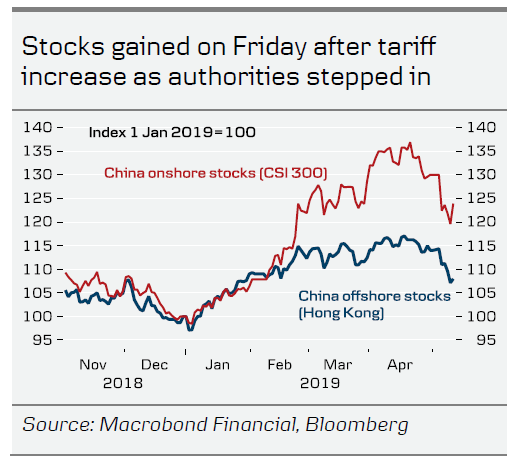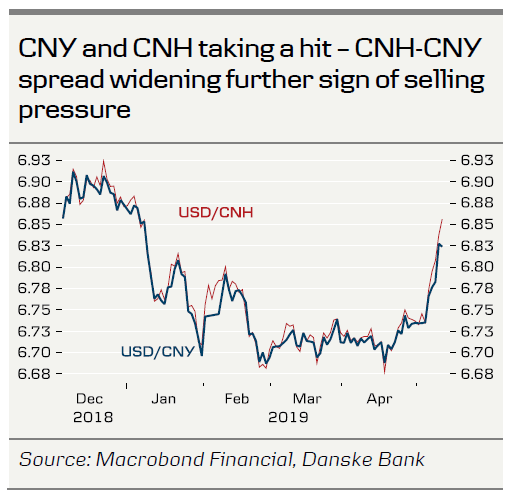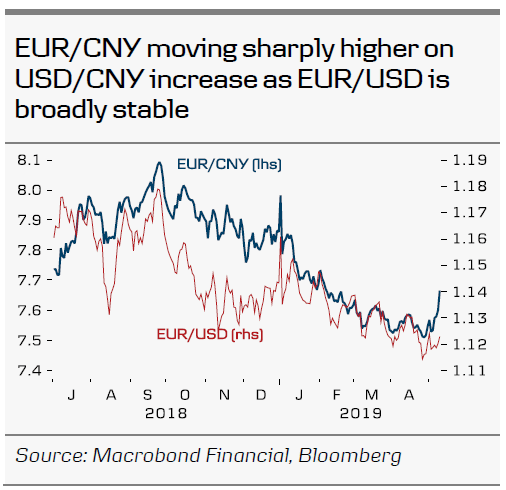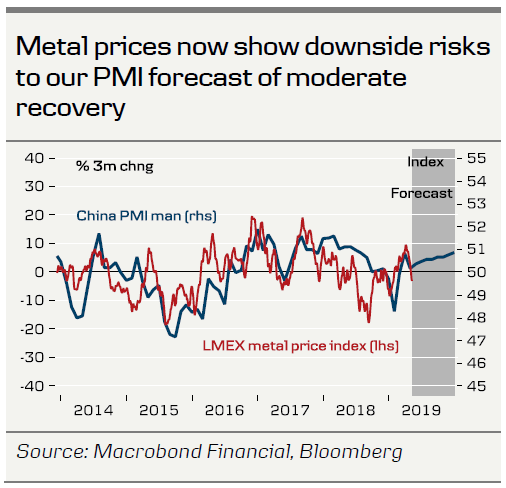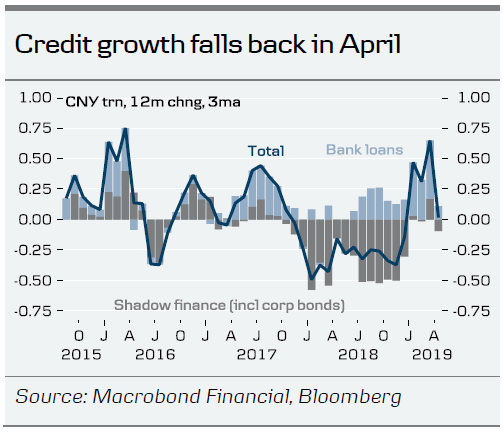- Six months of progress in trade talks have ended abruptly. There is now a clear risk that a deal will not be reached until H2 and a period of financial stress will be needed to get us there.
- CNY took a big hit this week and weakening pressure is set to persist short term.
- More data for April disappointed, confirming that key figures for March were too good to be true. The outlook is blurred by renewed trade tensions.
More tariffs set to restart the trade war
Our call last week that a trade deal was just around the corner turned out to be far too brave. Here is what we know happened over the past week based on media reports: The US trade team became angry over China backtracking on parts of the deal that the US saw as crucial. When China sent a revised draft deal on Friday evening (last week) with many changes, it triggered anger on the US side. Among other things, China declined to implement changes into Chinese law and Chinese Vice-Premier Liu He urged that the US trusted that China implement the particular elements through changes of regulation and administrative procedures. After the US trade representative had briefed Donald Trump on the revisions, a decision was taken to implement the tariffs to put pressure on China.
US Treasury Secretary Stephen Mnuchin said at a press conference that the tariffs would be implemented unless China offered concessions at planned talks on Thursday. However, following 1.5 hours of talks on Thursday night, the two sides separated and sources close to the talks said there was little to no progress. At 00:01 on Friday, the tariff increase from 10% to 25% on USD200bn of Chinese goods came into force. At 00.03, a Chinese spokesman from the Commerce Ministry said China deeply regretted the move and that China was forced to retaliate (see also China Notes – US hikes tariffs leaving high uncertainty in place , 10 May).
On Friday morning, Trump posted a long tweet threat saying the process has begun to place additional tariffs at 25% on the remaining USD325bn. In addition, he boasted how ‘China would greatly slow down and we would automatically speed up!’. However, he deleted the tweet threat and then put it back on except the last bit about China greatly slowing down – until an hour later when he added that bit back too. In another tweet , he wrote ‘This is not the Obama Administration, or the Administration of Sleepy Joe, who let China get away with ‘murder!”.
Comment: The situation is getting very tricky because the hawks are strengthened on both sides and Trump is clearly escalating with his rhetoric on China (this will be seen as a humiliation) and starting the process of adding tariffs on the rest of Chinese imports . Our best guess is that talks will come to a halt and that the US and China could go into a war of attrition. On the US side, the hawks are now in the driver’s seat , as they have a stronger case, saying that China cannot be trusted after it changed what the US viewed as a solid agreement. They may insist even more that Chinese laws change.
The Chinese side will find it harder to give concessions after Trump just raised tariffs and announced more is coming on the rest of Chinese exports. It would leave the impression the US can bully China into concessions. In addition, changing Chinese laws due to US pressure would be déjà vu to the Opium Wars in the 19th century, which resulted in China being forced into humiliating trade treaties with Western powers that violated Chinese sovereignty.
There is clear risk we need to see more pain from the trade war on both sides before serious talks are resumed and we may very well need to get into H2 before we reach a deal. Another bout of financial stress and economic damage may be needed to push Trump into a new attempt of reaching a deal. A new game of chicken could have started, which takes us closer to the brink of an all-out trade war. China may believe it has time on its side because Trump is heading into an election campaign and that Trump underestimates the pain that will be inflicted on the US economy by a full-blown trade war. If Trump carries out the tariffs on the rest of imports from China, Chinese consumers may react by boycotting US products. Businesses would feel more pain and question Trump’s strategy for getting concessions out of China even more.
USD/CNY moving sharply higher, risk of a further increase
The trade war escalation has led to a sharp weakening of the CNY, as the case for more monetary easing is increasing. Companies are probably also increasing their hedges of CNY income. The USD/CNH has increased more than USD/CNY, which is typically a sign that a lot of short selling and hedging is going on.
The Chinese stock market sold off this week and was under pressure following the tariff increase. However, equities turned around quickly, as authorities were said to support the market. Chinese stocks finished up 3.6% on Friday.
Comment: The fear of an all-out trade war is becoming visible in the currency market. With the risk that things in the trade talks get worse from here, we see scope for a further increase in USD/CNY in the short term. We intend to update our forecasts next week.
Although Chinese stocks have fallen a lot this week, we see a risk of further declines if trade talks derail.
Data for April disappoints across the board
More data for April undershot expectations this week. Credit growth fell back in April after a very strong Q1. Money growth (M1) slipped back to 2.9% y/y from 4.6% y/y but is still up from the lows in January. Export growth fell back into negative territory at -2.7% y/y, down from 13.8% y/y in April. Metal prices slid further over the week as trade war tensions increased.
Comment: The setback in April was to be expected after very strong March data, so we are not too concerned about it. However, the escalation of the trade war is worrying. Unless things calm down quick, which is hard to see right now, then we should expect China to announce more easing measures soon – both a cut in the reserve requirement ratio and measures to lift consumption. We now see downside risks to the short-term picture in China, as uncertainty has gone up and companies and consumers will be reluctant to spend with the threat of 25% tariffs on all Chinese exports hanging in the air.




